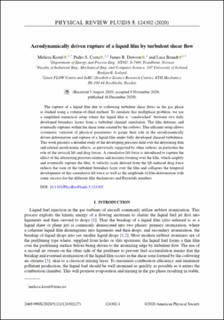| dc.contributor.author | Kozul, Melissa | |
| dc.contributor.author | Costa, Pedro S. | |
| dc.contributor.author | Dawson, James | |
| dc.contributor.author | Brandt, Luca | |
| dc.date.accessioned | 2021-09-24T09:07:05Z | |
| dc.date.available | 2021-09-24T09:07:05Z | |
| dc.date.created | 2021-02-14T05:46:23Z | |
| dc.date.issued | 2020 | |
| dc.identifier.issn | 2469-990X | |
| dc.identifier.uri | https://hdl.handle.net/11250/2781341 | |
| dc.description.abstract | The rupture of a liquid film due to coflowing turbulent shear flows in the gas phase is studied using a volume-of-fluid method. To simulate this multiphase problem, we use a simplified numerical setup where the liquid film is “sandwiched” between two fully developed boundary layers from a turbulent channel simulation. The film deforms and eventually ruptures within the shear zone created by the coflows. This efficient setup allows systematic variation of physical parameters to gauge their role in the aerodynamically driven deformation and rupture of a liquid film under fully developed sheared turbulence. This work presents a detailed study of the developing pressure field over the deforming film and related aerodynamic effects, as previously suggested by other authors, in particular the role of the inviscid lift and drag forces. A cumulative lift force is introduced to capture the effect of the alternating pressure minima and maxima forming over the film, which amplify and eventually rupture the film. A velocity scale derived from the lift-induced drag force reflects the state of the turbulent boundary layer over the film and collapses the temporal development of this cumulative lift force as well as the amplitude of film deformation with some success for the different film thicknesses and Reynolds numbers. | en_US |
| dc.language.iso | eng | en_US |
| dc.publisher | American Physical Society | en_US |
| dc.title | Aerodynamically driven rupture of a liquid film by turbulent shear flow | en_US |
| dc.type | Peer reviewed | en_US |
| dc.type | Journal article | en_US |
| dc.description.version | publishedVersion | en_US |
| dc.rights.holder | © 2020 American Physical Society | en_US |
| dc.source.volume | 5 | en_US |
| dc.source.journal | Physical Review Fluids | en_US |
| dc.source.issue | 124302 | en_US |
| dc.identifier.doi | 10.1103/PhysRevFluids.5.124302 | |
| dc.identifier.cristin | 1889568 | |
| dc.relation.project | Notur/NorStore: NN9611K | en_US |
| cristin.ispublished | true | |
| cristin.fulltext | preprint | |
| cristin.qualitycode | 1 | |
